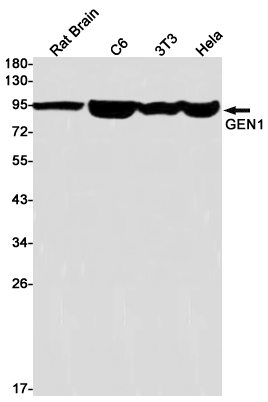-
Product Name
Anti-GEN1 Rabbit antibody
- Documents
-
Description
GEN1 Rabbit polyclonal antibody
-
Tested applications
WB
-
Species reactivity
Human, Rat
-
Alternative names
Gen antibody
-
Isotype
Rabbit IgG
-
Preparation
Antigen: A synthetic peptide of human GEN1
-
Clonality
Polyclonal
-
Formulation
Supplied in 50nM Tris-Glycine(pH 7.4), 0.15M Nacl, 40%Glycerol, 0.01% sodium azide and 0.05% BSA.
-
Storage instructions
Store at -20°C. Stable for 12 months from date of receipt.
-
Applications
WB: 1/1000
-
Validations

Western blot detection of GEN1 in Rat Brain,C6,3T3,Hela cell lysates using GEN1 Rabbit pAb(1:1000 diluted).Predicted band size:103kDa.Observed band size:103kDa.
-
Background
Swiss-Prot Acc.Q17RS7.Endonuclease which resolves Holliday junctions (HJs) by the introduction of symmetrically related cuts across the junction point, to produce nicked duplex products in which the nicks can be readily ligated. Four-way DNA intermediates, also known as Holliday junctions, are formed during homologous recombination and DNA repair, and their resolution is necessary for proper chromosome segregation (PubMed:19020614, PubMed:26682650). Cleaves HJs by a nick and counter-nick mechanism involving dual coordinated incisions that lead to the formation of ligatable nicked duplex products. Cleavage of the first strand is rate limiting, while second strand cleavage is rapid. Largely monomeric, dimerizes on the HJ and the first nick occurs upon dimerization at the junction (PubMed:26578604). Efficiently cleaves both single and double HJs contained within large recombination intermediates. Exhibits a weak sequence preference for incision between two G residues that reside in a T-rich region of DNA (PubMed:28049850). Has also endonuclease activity on 5'-flap and replication fork (RF) DNA substrates (PubMed:26578604).
Related Products / Services
Please note: All products are "FOR RESEARCH USE ONLY AND ARE NOT INTENDED FOR DIAGNOSTIC OR THERAPEUTIC USE"
